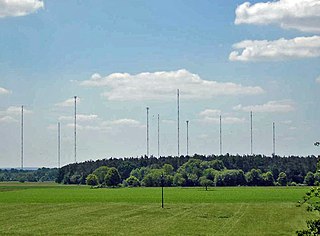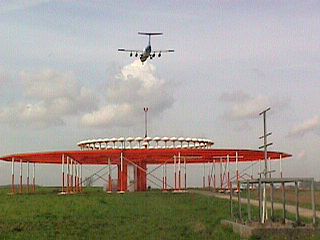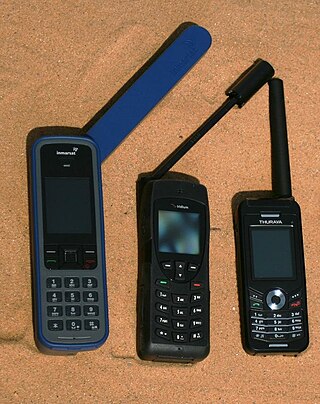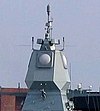The ITU Radio Regulations (RR) is a basic document of the International Telecommunication Union (ITU) that regulates on law of nations scale radiocommunication services and the utilisation of radio frequencies. It is the supplementation to the ITU Constitution and Convention and in line with the ITU International Telecommunication Regulations (ITR). The ITU RR comprise and regulate the part of the allocated electromagnetic spectrum from 9 kHz to 300 GHz.

Radio navigation or radionavigation is the application of radio frequencies to determine a position of an object on the Earth, either the vessel or an obstruction. Like radiolocation, it is a type of radiodetermination.
Radiolocation, also known as radiolocating or radiopositioning, is the process of finding the location of something through the use of radio waves. It generally refers to passive uses, particularly radar—as well as detecting buried cables, water mains, and other public utilities. It is similar to radionavigation, but radiolocation usually refers to passively finding a distant object rather than actively one's own position; both are types of radiodetermination. Radiolocation is also used in real-time locating systems (RTLS) for tracking valuable assets.

Fixed-satellite service is – according to article 1.21 of the International Telecommunication Union's (ITU) Radio Regulations (RR) – defined as A radiocommunication service between earth stations at given positions, when one or more satellites are used; the given position may be a specified fixed point or any fixed point within specified areas; in some cases this service includes satellite-to-satellite links, which may also be operated in the inter-satellite service; the fixed-satellite service may also include feeder links for other space radiocommunication services.
An amateur radio satellite is an artificial satellite built and used by amateur radio operators. It forms part of the Amateur-satellite service. These satellites use amateur radio frequency allocations to facilitate communication between amateur radio stations.
Mobile service is – in line to ITU Radio Regulations – a radiocommunication service between mobile and land stations, or between mobile stations (CV).

Standard frequency and time signal service is, according to Article 1.53 of the International Telecommunication Union's (ITU) Radio Regulations (RR), "A radiocommunication service for scientific, technical and other purposes, providing the transmission of specified frequencies, time signals, or both, of stated high precision, intended for general reception".

Space research service is – according to Article 1.55 of the International Telecommunication Union's (ITU) Radio Regulations (RR) – defined as «A radiocommunication service in which spacecraft or other objects in space are used for scientific or technological research purposes.»

Safety service is – according to Article 1.59 of the International Telecommunication Union's (ITU) Radio Regulations (RR) – defined as «A radiocommunication service used permanently or temporarily for the safeguarding of human life and property.»

Land mobile-satellite service is – according to Article 1.27 of the International Telecommunication Union's (ITU) Radio Regulations (RR) – defined as «A mobile-satellite service in which mobile earth stations are located on land.»
A maritime mobile service is a mobile service between coast stations and ship stations, or between ship stations, or between associated on-board communication stations. The service may also be used by survival craft stations and emergency position-indicating radiobeacon stations.

Maritime mobile-satellite service is – according to Article 1.29 of the International Telecommunication Union's Radio Regulations (RR) – "A mobile-satellite service in which mobile earth stations are located on board ships; survival craft stations and emergency position-indicating radiobeacon stations may also participate in this service", in addition to serving as navigation systems.

Aeronautical mobile service is – according to Article 1.32 of the International Telecommunication Union's (ITU) Radio Regulations (RR) – defined as "A mobile service between aeronautical stations and aircraft stations, or between aircraft stations, in which survival craft stations may participate; emergency position-indicating radiobeacon stations may also participate in this service on designated distress and emergency frequencies."

Aeronautical mobile-satellite service is – according to Article 1.35 of the International Telecommunication Union's (ITU) Radio Regulations (RR) – defined as «A mobile-satellite service in which mobile earth stations are located on board aircraft; survival craft stations and emergency position-indicating radiobeacon stations may also participate in this service. . »

Aeronautical mobile (R) service is – according to Article 1.33 of the International Telecommunication Union's (ITU) Radio Regulations (RR) – defined as "An aeronautical mobile service reserved for communications relating to safety and regularity of flight, primarily along national or international civil air routes."

Aeronautical mobile (OR) service is – according to Article 1.34 of the International Telecommunication Union's (ITU) Radio Regulations (RR) – defined as "An aeronautical mobile service intended for communications, including those relating to flight coordination, primarily outside national or international civil air routes".

Aeronautical mobile-satellite (R)° service is – according to Article 1.36 of the International Telecommunication Union's (ITU) Radio Regulations (RR) – defined as «An aeronautical mobile-satellite service reserved for communications relating to safety and regularity of flights, primarily along national or international civil air routes.»

Aeronautical mobile-satellite (OR)°° service is – according to Article 1.37 of the International Telecommunication Union's (ITU) Radio Regulations (RR) – defined as «An aeronautical mobile-satellite service reserved for communications relating to safety and regularity of flights, primarily outside national or international civil air routes.»

Standard frequency and time signal-satellite service is, according to Article 1.54 of the International Telecommunication Union's (ITU) Radio Regulations (RR), defined as A radiocommunication service using space stations on earth satellites for the same purposes as those of the standard frequency and time signal service.

Broadcasting-satellite service is – according to Article 1.39 of the International Telecommunication Union's (ITU) Radio Regulations (RR) – defined as «A radiocommunication service in which signals transmitted or retransmitted by space stations are intended for direct reception by the general public. In the broadcasting-satellite service, the term “direct reception” shall encompass both individual reception and community reception.»





























